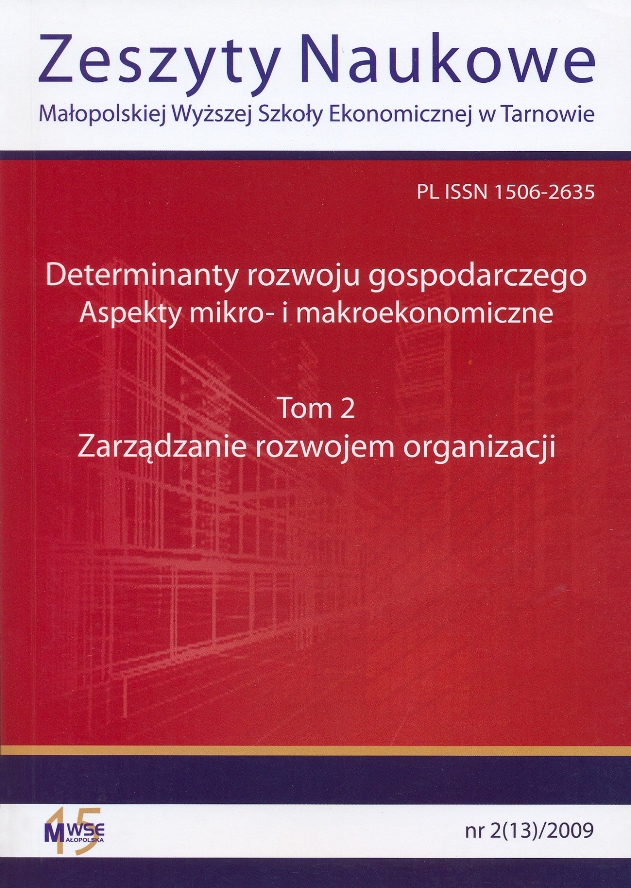Abstract
The author focus on presentation and analysis of main factors having influence on successful and efficient consolidation process. The results introduced in a lecture come from two global reports prepared by the Hay Group in cooperation with La Sorbonne and Mergermarket. The third report shows the studies conducted by Capital Market Area of BZ WBK. The Hay Group has identified two key factors, which provide a firm foundation for a smooth integration process, which companies should adopt to become the part of few successful few. The first one is striking the right balance. Companies should carefully consider how to align and integrate both tangible and intangible assets to be successfully merged, as well as use properly the time between announcement and completion to advance fully both tangible and intangible assets. The second factor is the impact of leadership. We need to acknowledge here, that the roles required in a M&A context are often one or two levels higher than current capacity of senior managers. Top team selection needs to be carried out quickly, as the sooner key roles are defined and allocated, the better level of integration between organizations we can achieve. The top team must also demonstrate the new company values to the workforce in everything they do. The research of Capital Market Area of BZ WBK points out poor preparation of a consolidation process made by Polish companies. In specialists' opinion companies do not analyze potential benefits, which may be achieved in M&A transactions. Most of interviewed managers point out the necessity of better preparation of an integration plan, as well as due diligence analyze in future consolidation processes. The results confirm, that the benefits a successful merger can gain are indisputable. Despite the impact of recent sub-prime lending on the average the availability of credit overall, M&A remains a trusted weapon in the growth strategies of organizations. Customers must pay due attention to a company's real value, which is found in its boardroom, human capital and business culture. When the balance is achieved between tangible and intangible assets, it provides a solid foundation for strategic growth and ensures return on investment.
References
Bresman H., Birkinshaw J., Nobel R. 1999. Knowledge Transfer in International Acquisitions. "Journal of International Business Studies" 3rd Quarter nr 30, s. 3.
View in Google Scholar
Czynniki sukcesu przy transakcjach fuzji i przejąć. Rynki kapitałowe. 2008. [on-line; dostęp: 2009-05-27]. Obszar Rynków Kapitałowych BZ WBK.. Dostępny w Internecie: http://www.ork.bzwbk.pl/_items/doc/czynniki_sukcesu_transakcji.pdf.
View in Google Scholar
Dangerous Liaisons: The Integration Game. 2007. [on-line; dostęp: 2009-05-27]. Hay Group. Dostępny w Internecie: http://www.haygroup.com/Downloads/ru/misc/Dangerous_liaisons.pdf.
View in Google Scholar
Fuzje i przejęcia - wyniki badania Hay Group i Mergermarket. 2009. [on-line; dostęp: 2009-05-27], Hay Group. Dostępny w Internecie: http://www.haygroup.com/pl/Press/Details.aspx?ID= 14067.
View in Google Scholar
Hooke J.C. 1998. Fuzje i przejęcia. Jak skutecznie przeprowadzić transakcję. Warszawa: Liber. ISBN 83-9095-027-8.
View in Google Scholar
Lewandowski M. 1998. Fuzje i przejęcia jako metody wzrostu przedsiębiorstw. Materiały Dydaktyczne nr 30. Poznań: Akademia Ekonomiczna. ISSN 1427-1117.
View in Google Scholar
Sudarsanam S. 1998. Fuzje i przejęcia. Warszawa: WIG-PRESS. ISBN 83-8701-408-7.
View in Google Scholar
Szczepankowski P.J. 2000. Fuzje i przejęcia. Warszawa: PWN. ISBN 83-01-13131-4.
View in Google Scholar
Zorde A.H.K. 1998. Fuzje i przejęcia przedsiębiorstw. Warszawa: Fundacja Rozwoju Rachunkowości w Polsce. ISBN 83-8654-325-6.
View in Google Scholar
© Copyright by Małopolska School of Economics in Tarnów. The articles are available under the Creative Commons Attribution NonCommercial-NoDerivatives 4.0 International License


